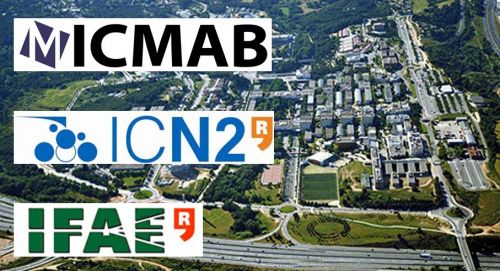
04/05/2017
Reference research centres in the environment of the Barcelona Synchrotron Park
Reference research centres in the environment of the Barcelona Synchrotron Park
The recently updated Nature Index, which tracks the researcher affiliations collected from worldwide high quality scientific articles, provides a good opportunity to speak about three important research centres installed on the campus of the UAB university, the Barcelona Synchrotron Park‘s partner: ICMAB, ICN2 and IFAE.
The Institute of Materials Science of Barcelona (ICMAB) has been recognized with many successes during these last years, including 9 ERC Projects awarded to its researchers. In the latest Nature Index, ICMAB is ranked in the top 4 research centres in Catalonia and Spain, only behind three other Catalan centres: the ICIQ (Institute of Chemical Research of Catalonia), the ICFO (Institute of Photonic Sciences) and the ICN2 (Catalan Institute of Nanoscience and Nanotechnology) also set up on the UAB campus.
The Institute for High Energy Physics (IFAE) also settled on the UAB campus, has been recently in the news: among the research team that published last month intriguing anomalies in the way some particles decay, 2 of the 5 researchers that analysed data from the Large Hadron Collider (LHC, CERN) and other experiments, are from the IFAE. If confirmed, these results would be a sign of new physics phenomena not predicted by the Standard Model of particle physics.
Finally, let’s mention that both ICN2 and IFAE, jointly with ICFO, ICIQ, IRB (Institute for Research in Biomedicine) and CRG (Centre for Genomic Regulation) form the new Barcelona Institute of Science and Technology (BIST) that aims to construct a scientific project based on the search for the complementary and interdisciplinary of fields, not only to promote the creation of innovative projects, but also to provide the most competitive environment for the training of scientists. According to Nature Index, BIST with its 1,400 researchers ranks 24 in Europe.
The Institute of Materials Science of Barcelona (ICMAB) has been recognized with many successes during these last years, including 9 ERC Projects awarded to its researchers. In the latest Nature Index, ICMAB is ranked in the top 4 research centres in Catalonia and Spain, only behind three other Catalan centres: the ICIQ (Institute of Chemical Research of Catalonia), the ICFO (Institute of Photonic Sciences) and the ICN2 (Catalan Institute of Nanoscience and Nanotechnology) also set up on the UAB campus.
The Institute for High Energy Physics (IFAE) also settled on the UAB campus, has been recently in the news: among the research team that published last month intriguing anomalies in the way some particles decay, 2 of the 5 researchers that analysed data from the Large Hadron Collider (LHC, CERN) and other experiments, are from the IFAE. If confirmed, these results would be a sign of new physics phenomena not predicted by the Standard Model of particle physics.
Finally, let’s mention that both ICN2 and IFAE, jointly with ICFO, ICIQ, IRB (Institute for Research in Biomedicine) and CRG (Centre for Genomic Regulation) form the new Barcelona Institute of Science and Technology (BIST) that aims to construct a scientific project based on the search for the complementary and interdisciplinary of fields, not only to promote the creation of innovative projects, but also to provide the most competitive environment for the training of scientists. According to Nature Index, BIST with its 1,400 researchers ranks 24 in Europe.
More news
26/03/2014
New companies in the UAB Research Park
18/03/2014
The public-private partnership ESTEVE-UAB is bearing fruit
11/03/2014
Barcelona ranked fourth place among the most attractive European cities for investors
24/02/2014
Zero2infinity offers sightseeing flights in the stratosphere
18/02/2014
Students from Harvard visited the Barcelona Synchrotron Park and ALBA
11/02/2014
Applications of the Alba synchrotron in the materials and chemistry industries









